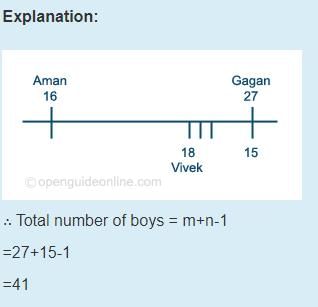CLAT Exam > CLAT Questions > Amar is 16th from the left end in a row of bo...
Start Learning for Free
Amar is 16th from the left end in a row of boys and Vishal is 18th from the right end. Ganesh is 11th from Amar towards the right and 3rd from Vishal towards the right end. How many boys are there in the row?
- a)45
- b)26
- c)39
- d)41
- e)None of these
Correct answer is option 'D'. Can you explain this answer?
Verified Answer
Amar is 16th from the left end in a row of boys and Vishal is 18th fro...

Most Upvoted Answer
Amar is 16th from the left end in a row of boys and Vishal is 18th fro...
Given information:
- Amar is 16th from the left end.
- Vishal is 18th from the right end.
- Ganesh is 11th from Amar towards the right.
- Ganesh is 3rd from Vishal towards the right end.
To find: How many boys are there in the row?
Solution:
1. Let's first find the position of Ganesh from the left end of the row.
- We know that Ganesh is 11th from Amar towards the right.
- So, the position of Amar from the right end can be calculated as: Total number of boys - 16 + 1 (including Amar himself) = Total number of boys - 15.
- Hence, the position of Ganesh from the left end can be calculated as: Total number of boys - 15 - 11 + 1 (including Ganesh himself) = Total number of boys - 24.
2. Now, we can use the second piece of information to find the position of Ganesh from the left end.
- We know that Ganesh is 3rd from Vishal towards the right end.
- So, the position of Vishal from the left end can be calculated as: Total number of boys - 18 + 1 (including Vishal himself) = Total number of boys - 17.
- Hence, the position of Ganesh from the left end can be calculated as: Total number of boys - 17 - 3 + 1 (including Ganesh himself) = Total number of boys - 19.
3. Equating the two expressions we got for the position of Ganesh from the left end, we get:
Total number of boys - 24 = Total number of boys - 19.
Solving this equation, we get:
Total number of boys = 41.
Therefore, there are 41 boys in the row. Hence, option D is the correct answer.
- Amar is 16th from the left end.
- Vishal is 18th from the right end.
- Ganesh is 11th from Amar towards the right.
- Ganesh is 3rd from Vishal towards the right end.
To find: How many boys are there in the row?
Solution:
1. Let's first find the position of Ganesh from the left end of the row.
- We know that Ganesh is 11th from Amar towards the right.
- So, the position of Amar from the right end can be calculated as: Total number of boys - 16 + 1 (including Amar himself) = Total number of boys - 15.
- Hence, the position of Ganesh from the left end can be calculated as: Total number of boys - 15 - 11 + 1 (including Ganesh himself) = Total number of boys - 24.
2. Now, we can use the second piece of information to find the position of Ganesh from the left end.
- We know that Ganesh is 3rd from Vishal towards the right end.
- So, the position of Vishal from the left end can be calculated as: Total number of boys - 18 + 1 (including Vishal himself) = Total number of boys - 17.
- Hence, the position of Ganesh from the left end can be calculated as: Total number of boys - 17 - 3 + 1 (including Ganesh himself) = Total number of boys - 19.
3. Equating the two expressions we got for the position of Ganesh from the left end, we get:
Total number of boys - 24 = Total number of boys - 19.
Solving this equation, we get:
Total number of boys = 41.
Therefore, there are 41 boys in the row. Hence, option D is the correct answer.
Community Answer
Amar is 16th from the left end in a row of boys and Vishal is 18th fro...
Ganesh's position is given from left as well as right ,from left he is on 27th position i.e (amar's position +Ganesh's position) and from left he is on 15th (Ganesh"s position _vishsl's position) now that we know the position of one person from left and right we just have to put it on the formula i.e (position of a person from left same from right)_1 and we get the ans

|
Explore Courses for CLAT exam
|

|
Question Description
Amar is 16th from the left end in a row of boys and Vishal is 18th from the right end. Ganesh is 11th from Amar towards the right and 3rd from Vishal towards the right end. How many boys are there in the row?a)45b)26c)39d)41e)None of theseCorrect answer is option 'D'. Can you explain this answer? for CLAT 2025 is part of CLAT preparation. The Question and answers have been prepared according to the CLAT exam syllabus. Information about Amar is 16th from the left end in a row of boys and Vishal is 18th from the right end. Ganesh is 11th from Amar towards the right and 3rd from Vishal towards the right end. How many boys are there in the row?a)45b)26c)39d)41e)None of theseCorrect answer is option 'D'. Can you explain this answer? covers all topics & solutions for CLAT 2025 Exam. Find important definitions, questions, meanings, examples, exercises and tests below for Amar is 16th from the left end in a row of boys and Vishal is 18th from the right end. Ganesh is 11th from Amar towards the right and 3rd from Vishal towards the right end. How many boys are there in the row?a)45b)26c)39d)41e)None of theseCorrect answer is option 'D'. Can you explain this answer?.
Amar is 16th from the left end in a row of boys and Vishal is 18th from the right end. Ganesh is 11th from Amar towards the right and 3rd from Vishal towards the right end. How many boys are there in the row?a)45b)26c)39d)41e)None of theseCorrect answer is option 'D'. Can you explain this answer? for CLAT 2025 is part of CLAT preparation. The Question and answers have been prepared according to the CLAT exam syllabus. Information about Amar is 16th from the left end in a row of boys and Vishal is 18th from the right end. Ganesh is 11th from Amar towards the right and 3rd from Vishal towards the right end. How many boys are there in the row?a)45b)26c)39d)41e)None of theseCorrect answer is option 'D'. Can you explain this answer? covers all topics & solutions for CLAT 2025 Exam. Find important definitions, questions, meanings, examples, exercises and tests below for Amar is 16th from the left end in a row of boys and Vishal is 18th from the right end. Ganesh is 11th from Amar towards the right and 3rd from Vishal towards the right end. How many boys are there in the row?a)45b)26c)39d)41e)None of theseCorrect answer is option 'D'. Can you explain this answer?.
Solutions for Amar is 16th from the left end in a row of boys and Vishal is 18th from the right end. Ganesh is 11th from Amar towards the right and 3rd from Vishal towards the right end. How many boys are there in the row?a)45b)26c)39d)41e)None of theseCorrect answer is option 'D'. Can you explain this answer? in English & in Hindi are available as part of our courses for CLAT.
Download more important topics, notes, lectures and mock test series for CLAT Exam by signing up for free.
Here you can find the meaning of Amar is 16th from the left end in a row of boys and Vishal is 18th from the right end. Ganesh is 11th from Amar towards the right and 3rd from Vishal towards the right end. How many boys are there in the row?a)45b)26c)39d)41e)None of theseCorrect answer is option 'D'. Can you explain this answer? defined & explained in the simplest way possible. Besides giving the explanation of
Amar is 16th from the left end in a row of boys and Vishal is 18th from the right end. Ganesh is 11th from Amar towards the right and 3rd from Vishal towards the right end. How many boys are there in the row?a)45b)26c)39d)41e)None of theseCorrect answer is option 'D'. Can you explain this answer?, a detailed solution for Amar is 16th from the left end in a row of boys and Vishal is 18th from the right end. Ganesh is 11th from Amar towards the right and 3rd from Vishal towards the right end. How many boys are there in the row?a)45b)26c)39d)41e)None of theseCorrect answer is option 'D'. Can you explain this answer? has been provided alongside types of Amar is 16th from the left end in a row of boys and Vishal is 18th from the right end. Ganesh is 11th from Amar towards the right and 3rd from Vishal towards the right end. How many boys are there in the row?a)45b)26c)39d)41e)None of theseCorrect answer is option 'D'. Can you explain this answer? theory, EduRev gives you an
ample number of questions to practice Amar is 16th from the left end in a row of boys and Vishal is 18th from the right end. Ganesh is 11th from Amar towards the right and 3rd from Vishal towards the right end. How many boys are there in the row?a)45b)26c)39d)41e)None of theseCorrect answer is option 'D'. Can you explain this answer? tests, examples and also practice CLAT tests.

|
Explore Courses for CLAT exam
|

|
Signup for Free!
Signup to see your scores go up within 7 days! Learn & Practice with 1000+ FREE Notes, Videos & Tests.



















